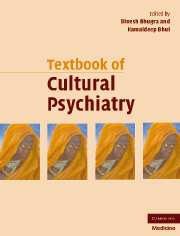Book contents
- Frontmatter
- Contents
- Contributors
- Foreword
- Preface
- Part I Theoretical background
- Part II Culture and mental health
- Part III Culture and mental disorders
- 15 Neurosis
- 16 Schizophrenia and related psychoses
- 17 Affective disorders
- 18 Substance misuse
- 19 Culture and mental disorders: suicidal behaviour
- 20 Personality disorders and culture
- 21 Culture and obsessive-compulsive disorder
- 22 Culture and eating disorders
- 23 Childhood and adolescent psychiatric disorders
- 24 Culture and schizophrenia
- 25 Disorders of ageing across cultures
- Part IV Theoretical aspects of management
- Part V Management with special groups
- Part VI Cultural research and training
- Cultural psychiatry: the past and the future
- Index
- References
23 - Childhood and adolescent psychiatric disorders
from Part III - Culture and mental disorders
Published online by Cambridge University Press: 11 August 2009
- Frontmatter
- Contents
- Contributors
- Foreword
- Preface
- Part I Theoretical background
- Part II Culture and mental health
- Part III Culture and mental disorders
- 15 Neurosis
- 16 Schizophrenia and related psychoses
- 17 Affective disorders
- 18 Substance misuse
- 19 Culture and mental disorders: suicidal behaviour
- 20 Personality disorders and culture
- 21 Culture and obsessive-compulsive disorder
- 22 Culture and eating disorders
- 23 Childhood and adolescent psychiatric disorders
- 24 Culture and schizophrenia
- 25 Disorders of ageing across cultures
- Part IV Theoretical aspects of management
- Part V Management with special groups
- Part VI Cultural research and training
- Cultural psychiatry: the past and the future
- Index
- References
Summary
EDITORS' INTRODUCTION
One of the key components of culture is the child-rearing patterns, and within each setting the child absorbs cultural values without actually being aware of this. The roles allocated to and expected of children and adolescents indicate cultural expectations and norms. The definitions of illness in childhood are also affected by cultural mores. The bringing up of children, parenting and attachment patterns are all influenced by cultures. In collectivist cultures kinship will be responsible for bringing the children up in times of disaster and within such settings multiple parental roles will exist. This raises interesting questions about development of the individual as well as their concepts of the self.
Dogra and colleagues in this chapter place childhood and adolescent disorders in the context of the cultures. Comparative and cultural analysis reveals a variety of childhoods. Using a multi-dimensional aspect of culture and a social constructionist view, these authors emphasize that, as children and adolescents do not often present themselves to services, the context of the family becomes crucial and the expectations of the families and cultures placed on them will change in response to various external factors. The prevalence of psychiatric disorders in different cultures and in different ethnic groups varies according to a number of factors. Cultural and ethnic factors are also associated with differential access to healthcare services in a similar way as seen in adults. Referral bias, low cultural competence, cultural differences in expression and tolerance of symptoms and help seeking behaviours all play a role.
- Type
- Chapter
- Information
- Textbook of Cultural Psychiatry , pp. 301 - 313Publisher: Cambridge University PressPrint publication year: 2007
References
- 2
- Cited by



